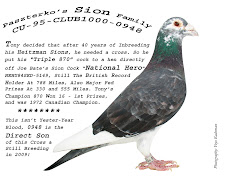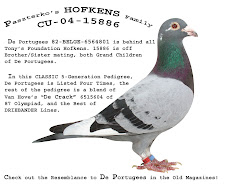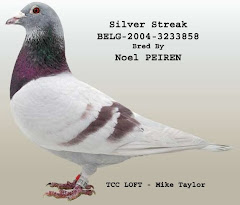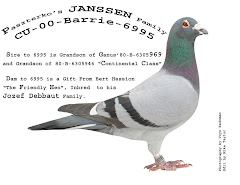The New York Times
By MARGALIT FOX
Published: December 13, 2008
Richard Topus helped American spies and the military in the swift, silent use of birds in wartime.
In January 1942, barely a month after Pearl Harbor, the United States War Department sounded a call to enlist. It wasn’t men they wanted — not this time. The Army was looking for pigeons.
To the thousands of American men and boys who raced homing pigeons, a popular sport in the early 20th century and afterward, the government’s message was clear: Uncle Sam Wants Your Birds.
Richard Topus was one of those boys. He had no birds of his own to give, but he had another, unassailable asset: he was from Brooklyn, where pigeon racing had long held the status of a secular religion. His already vast experience with pigeons — long, ardent hours spent tending and racing them after school and on weekends — qualified him, when he was still a teenager, to train American spies and other military personnel in the swift, silent use of the birds in wartime.
World War II saw the last wide-scale use of pigeons as agents of combat intelligence. Mr. Topus, just 18 when he enlisted in the Army, was among the last of the several thousand pigeoneers, as military handlers of the birds were known, who served the United States in the war.
A lifelong pigeon enthusiast who became a successful executive in the food industry, Mr. Topus died on Dec. 5 in Scottsdale, Ariz., at the age of 84. The cause was kidney failure, his son Andrew said.
Richard Topus was born in Brooklyn on March 15, 1924, the son of Russian Jewish immigrants. Growing up in Flatbush, he fell in love with the pigeons his neighbors kept on their rooftops in spacious coops known as lofts. His parents would not let him have a loft of his own — they feared it would interfere with schoolwork, Andrew Topus said — but he befriended several local men who taught him to handle their birds. Two of them had been pigeoneers in World War I, when the United States Army Pigeon Service was formally established.
Pigeons have been used as wartime messengers at least since antiquity. Before the advent of radio communications, the birds were routinely used as airborne couriers, carrying messages in tiny capsules strapped to their legs. A homing pigeon can find its way back to its loft from nearly a thousand miles away. Over short distances, it can fly a mile a minute. It can go where human couriers often cannot, flying over rough terrain and behind enemy lines.
By the early 20th century, advances in communications technology seemed to herald the end of combat pigeoneering. In 1903, a headline in The New York Times confidently declared, “No Further Need of Army Pigeons: They Have Been Superseded by the Adoption of Wireless Telegraph Systems.”
But technology, the Army discovered, has its drawbacks. Radio transmissions can be intercepted. Triangulated, they can reveal the sender’s location. In World War I, pigeons proved their continued usefulness in times of enforced radio silence. After the United States entered World War II, the Army put out the call for birds to racing clubs nationwide. Tens of thousands were donated.
In all, more than 50,000 pigeons served the United States in the war. Many were shot down. Others were set upon by falcons released by the Nazis to intercept them. (The British countered by releasing their own falcons to pursue German messenger pigeons. But since falcons found Allied and Axis birds equally delicious, their deployment as defensive weapons was soon abandoned by both sides.)
But many American pigeons did reach their destinations safely, relaying vital messages from soldiers in the field to Allied commanders. The information they carried — including reports on troop movements and tiny hand-sketched maps — has been widely credited with saving thousands of lives during the war.
Mr. Topus enlisted in early 1942 and was assigned to the Army Signal Corps, which included the Pigeon Service. He was eventually stationed at Camp Ritchie in Maryland, one of several installations around the country at which Army pigeons were raised and trained. There, he joined a small group of pigeoneers, not much bigger than a dozen men.
Camp Ritchie specialized in intelligence training, and Mr. Topus and his colleagues schooled men and birds in the art of war. They taught the men to feed and care for the birds; to fasten on the tiny capsules containing messages written on lightweight paper; to drop pigeons from airplanes; and to jump out of airplanes themselves, with pigeons tucked against their chests. The Army had the Maidenform Brassiere Company make paratroopers’ vests with special pigeon pockets.
The birds, for their part, were trained to fly back to lofts whose locations were changed constantly. This skill was crucial: once the pigeons were released by troops in Europe, the Pacific or another theater, they would need to fly back to mobile combat lofts in those places rather than light out for the United States. Mr. Topus and his colleagues also bred pigeons, seeking optimal combinations of speed and endurance.
After the war, Mr. Topus earned bachelor’s and master’s degrees in business from Hofstra University. While he was a student, he earned money selling eggs — chicken eggs — door to door and afterward started a wholesale egg business. In the late 1950s, Mr. Topus became the first salesman at Friendship Food Products, a dairy company then based in Maspeth, Queens; he retired as executive vice president for sales and marketing. (The company, today based in Jericho, N.Y. and a subsidiary of Dean Foods, is now known as Friendship Dairies.)
In the 1960s and early ’70s, Mr. Topus taught marketing at Hofstra; the C. W. Post campus of Long Island University; and the State University of New York, Farmingdale, where he started a management-training program for supermarket professionals. In later years, after retiring to Scottsdale, he taught at Arizona State University and was also a securities arbitrator, hearing disputes between stockbrokers and their clients.
Besides his son Andrew, of Chicago, Mr. Topus is survived by his wife, the former Jacqueline Buehler, whom he married in 1948; two other children, Nina Davis of Newton, Mass.; and David, of Atlanta; and four grandchildren.
Though the Army phased out pigeons in the late 1950s, Mr. Topus raced them avidly till nearly the end of his life. He left a covert, enduring legacy of his hobby at Friendship, for which he oversaw the design of the highly recognizable company logo, a graceful bird in flight, in the early 1960s.
From that day to this, the bird has adorned cartons of the company’s cottage cheese, sour cream, buttermilk and other products. To legions of unsuspecting consumers, Andrew Topus said last week, the bird looks like a dove. But to anyone who really knew his father, it is a pigeon, plain as day.
A version of this article appeared in print on December 14, 2008, on page A42 of the New York edition.
Read more ...







